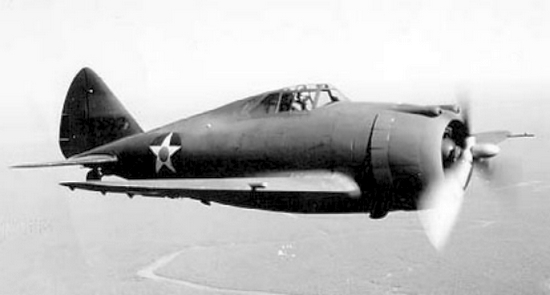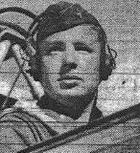Gordon Houston
| Date and Place of Birth: | March 20, 1917 Merrilton, AR |
| Date and Place of Death: | February 10, 1942 McChord Field, Tacoma, WA |
| Baseball Experience: | Minor League |
| Position: | Outfield |
| Rank: | Second Lieutenant |
| Military Unit: | 55th Pursuit Group USAAF |
| Area Served: | United States |
Gordon Houston was a minor league batting champion who hoped to someday make it to the coveted record books of the major leagues. His dream did come true, but not in the way he expected. Gordon Houston is remembered as the first professional baseball player to die in World War II.
Gordon E. Houston’s father, Charles (known as C. L.), worked as a
bookkeeper for an oil company, and as the company relocated around the
southern United States, so did the Houston family. They moved from
Clarksville, Arkansas, to Shreveport, Louisiana, in the early 1920s, and
were in Dallas, Texas, in the early 1930s. They eventually settled in
San Antonio, Texas, in 1937.
The Houston boys were exceptional athletes and inseparable. Gordon and
Charles, Jr. (known, like his father, as C. L.), were both stars on the
baseball and football teams at Sunset High School in the North Oak Cliff
area of Dallas. Following graduation from high school in 1934, they
enrolled at the College of the Ozarks, in Clarksville, Arkansas, and for
two years they attended college during the winter months and played
semi-pro baseball with a lumberyard team during the summer. In September
1936, they both enrolled at Henderson State Teacher’s College in
Arkadelphia, Arkansas, where they starred on the football team. By 1937,
the family had relocated to San Antonio, Texas, and the brothers
enrolled at local St. Mary’s University. In January 1938, they again
discontinued their studies to try out for the Monroe Twins of the Class
C Cotton States League.
Both were offered contracts and C. L. played shortstop and batted .315
in 21 games, while Gordon hit .320 in 46 games playing center field.
Patrolling the outfield grass for the Twins alongside Houston that
summer was Culley Rikard, who would join the Pittsburgh Pirates in 1941.
The brothers were back at St. Mary’s in September 1938, but went through
their familiar routine of discontinuing their studies in January of the
new year to pursue a summer career in baseball. They had heard that the
Texarkana Liners of the Class C East Texas League had appointed a new
manager for the season—former Athletics and Browns pitcher, Sam Gray—and
he would be looking for new players when the team started spring
training on March 1, 1938. The Liners—so-called because the town
straddles the Texas-Arkansas state line—were owned by Dick Burnet who
had made a fortune in East Texas oil fields during the early 1930s. He
owned the East Texas League’s Gladewater team in 1936, but low
attendance due to a small population appropriated a move to Texarkana in
1937.
C. L. was up against veteran shortstop Eph Lobaugh and was not offered a
deal with the Liners, while Gordon was, and had a career-best year.
Playing left field, and later moving to right field, Houston went 3 for
4 on Opening Day and led the league with a .384 batting average. In
fact, he stayed above .400 until mid–June and never hit below .380
throughout the season. He also hit 32 doubles and 18 home runs, stole 25
bases and had 70 RBIs; his .618 slugging percentage was second best in
the league. Playing in the midseason East Texas League North-South
all-star game on July 20 was quite an honor for young Houston; eleven of
the players in that game were past or future major leaguers. But Houston
proved his worth going 5-for-5 at the plate, scoring one run and driving
in another for the North. Immediately following the all-star contest, he
was traded to the Oklahoma City Indians of the Class A1 Texas League for
pitcher William Douglas. He made an immediate impact with his timely
hitting, helping the Indians to down the Houston Buffaloes, 5–4 and 3–2,
in a doubleheader on July 21. In four games with Oklahoma City, Houston
had two hits, but was later returned to Texarkana where he continued to
lead the league in hitting and was selected to the end-of-season
all-star team.
Texarkana finished second in the league, four-and-a-half games behind
the Marshall Tigers. They went on to win the first three playoff games
against the Henderson Oilers and appeared set for a place in the finals.
Henderson, however, came back to win the last four to upset the heavily
favored Liners. The fourth-place Tyler Trojans also upset Marshall in
five games and went on to defeat Henderson in the finals.
Gordon Houston was back with Texarkana in 1939 and looking forward to
another strong season, but on May 24, in a game against Longview, a
nasty spike wound to his foot put him on the sidelines for two weeks and
hampered his performance for the rest of the year. In 109 games, Houston
batted an uncharacteristic .219—165 points below his previous season
mark. His home run output dropped from 18 to three and he drove in just
39 runs. Houston’s 1940 season with Texarkana—his third with the
independently operated club—marked a return to form. He played a
career-high 129 games and led the team in hits (158), doubles (30) and
batting average (.304). It was a good year for the 24-year-old
outfielder but there were no offers to be seen from any major league
clubs, and 1940 was to be his last in professional baseball.
On November 3, 1940, Gordon and C. L. enlisted in the Army Air Corps
since they both wanted to be pilots. Gordon passed the eye exam—which
required 20/20 vision at that time—but C. L. did not. On February 10,
1941, while C. L. prepared for basic training in a ground-based role
with the Air Corps, Gordon reported for primary flight training as an
aviation cadet to Ontario Army Air Field, California. He advanced to
basic flight training at Moffett Field near San Jose, and was graduated
from the advanced flying school at Stockton Field, California in
September 1941. Second Lieutenant Houston was now a full-time fighter
pilot and took up his position as flight leader with the 55th Pursuit
Group, Western Defense Command, stationed at McChord Field, just south
of Tacoma, Washington. Piloting his Republic P-43 Lancer, a pre-war
fighter plane that never saw combat, it was Houston’s job to lead his
flight up and down the coast, looking for Japanese submarines or
aircraft carriers that might be tempted by the concentration of large
airplane manufacturing plants in that region. Ever since the War
Department’s warning message on November 27, 1941, indicating that
negotiations with Japan had terminated and that war was probable, the
Western Defense Command had accelerated its protection of the region,
and with good reason. On December 23, 1941, the tanker Montebello was
torpedoed and sunk off the coast of Cambria, California. As the crewmen
scrambled into four lifeboats, gunfire from the Japanese submarine’s
deck guns sailed over their heads. All the crew survived but the
Montebello, with 73,571 barrels of oil, lay at the bottom of the Pacific
Ocean.
During the afternoon of February 10, 1942, Houston’s flight was
preparing to land his P-43 at McChord Field after an uneventful sortie.
As he approached the runway another plane was coming in directly beneath
him. Houston was the more experienced pilot and climbed slightly so he
could head for the end of the runway and the overrun, a grassy area that
was used in case a plane overshoots a little. What Houston did not
realize about the overrun was that a ditch had been dug during the day
to lay some sewer tile. His plane, which had poor forward visibility
when taxiing, hit the ditch and flipped over. Houston’s death was
instantaneous. The family took the news of Gordon's death hard. More
than 20 years later, at the funeral of her husband, Gordon's mother,
Lydia, recalled her middle son. "When my grandfather died, I remember
her saying that as hard as it was to give him up, it wasn't as hard as
it was with Uncle Gordy," said Patty Rousher, the daughter of Gordon's
younger brother, Howard. "She said she never really got over it."
C. L., who was stationed at Kelly Field, Texas, at the time, had the
responsibility of going up to Washington to claim the body of his
younger brother. "I was stationed at McChord Field years later," says
C.L's son, Chuck, who served for many years with the Air Force. But his
father would never go up there and see him. "He said going up there
again would bring up a lot of bad memories."
Services were held at the Fort Sam Houston Post Chapel near San Antonio,
on February 14, 1942, and Gordon Houston was buried in the National
Cemetery at Fort Sam Houston with full military honors.
|
Team |
League |
Class |
G |
AB |
R |
H |
2B |
3B |
HR |
RBI |
AVG |
|
| 1937 | Monroe | Cotton States | C | 46 | 175 | 19 | 56 | 8 | 3 | 1 | 20 | .320 |
| 1938 | Texarkana | East Texas | C | 108 | 427 | 100 | 164 | 32 | 7 | 18 | 70 | .384 |
| 1938 | Oklahoma City | Texas | A1 | 7 | 22 | - | 6 | - | - | - | - | .272 |
| 1939 | Texarkana | East Texas | C | 109 | 375 | 51 | 82 | 18 | 2 | 3 | 39 | .219 |
| 1940 | Texarkana | East Texas | C | 129 | 519 | 80 | 158 | 30 | 3 | 5 | 57 | .304 |

Republic P-43 Lancer
Date Added February 1, 2012 Updated June 15, 2014
Baseball's Greatest Sacrifice is associated with Baseball Almanac
Baseball's Greatest Sacrifice is proud to be sponsored by

